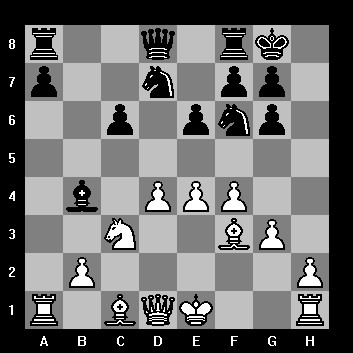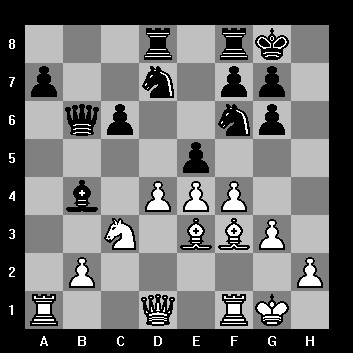07.10.2006
Game IX V.Topalov - V.Kramnik
1.d4 d5 2. c4 c6 3.Nf3 Nf6 4.e3 Bf5 5.Nc3 e6 6.Nh4 Bg6 7.Nxg6 hxg6 8.a3 Nbd7 9.g3 Be7 10.f4
As already usual in this match, opponents quit the main theoretical roads rather fast. Already 8.a3 was almost never tried, and with his next move white eventually left the theroretical path at all. The last move has much logic as preventive from possible e6-e5, yet is very obliging.

10...dxc4 Well, now we understand more clearly what may have been white's idea with idea a2-a3 and f2-f4. Capturing more space by c4-c5 could leave black not enough air to breath. 11.Bxc4 0-0 Black prepares c6-c5. White has two bishops, but c1-bishop at this moment seems hardly to adorn white's position, thus e3-e4 deserves attention. 12.e4
Black is bound to find a concrete solution immediately, otherwise his position will remain without any counterplay till the end. It seems that black should apply not so good-looking but logical in view of the situation move b7-b5 and then either immediate b5-b4, or Nd7-b6. 12...b5
12...b5 13.Be2 b4 14.axb4 Bxb4 15.Bf3

15...Qb6
15...c5 was to be checked, but probably in this case the logic of not opening the position for the opponents bishops must outweigh black slight leading in development: 16.e5 (16.Be3 Nb6 gives counterplay; 16.dxc5 Nc5 17.e5 Nfe4 is likely end up with the endgame on one half of the board) 16...Nd5 17.Bd2 and black is in trouble: 17...Bxc3 18.bxc3 cxd4 is met by 19.c4!
Although if we take a more thorough look, we can find an idea 16...cxd4! 17.Qd4 Nd5 18.Bxd5 and now black has a very important intermediate 18...Bc5 After 19.Qd3 exd5 both accepting the sacrifice by 20.Qd5 Qe7 or declining it 20.Kf1 g5!? lead to sharp interesting positions.
16.0-0 e5 17.Be3 Rad8
Now white has several means of solving the tension in the center: 17.Na4 followed by 18.Qc2, or 17.Qc2 with the idea 17...exd4 18.Na4, or 17.Bf2. In all the cases black positions causes serious apprehensions.

18.Na4 At the first sight, 18...Qb5 19.Qc2 exf4 and 20...Rfe8 appears to be the most stubborn. 18...Qb8 19.Qc2 exf4 20.Bxf4 Qb7 It is far from obvious, how should this seeming loss of tempo with Qb6-b8-b7 be explained. Probably black considered white's taking on f4 with the pawn "g" a more dangerous positional idea, and then we should suppose that either after 18...Qb7 19.Qc2 exf4 20.gxf4 Rfe8 black were disappointed by the fact that Nxe4 isn't a threat, or after 18...Qb7 19.Qb3!? exf4 20.gxf4 Rfe8 a return 21.Nc3 may be unpleasant.
21.Rad1 Rfe8 22.Bg5 Be7 23.Kh1 A useful prophylaxy. The evaluation of the position suggests itself, white has a definite advantage. White's assets are his strong center, space and two bishops, black pawns are separated and weak, and even g6 pawn may in some positions work in white's favour. Yet white's central pawns may come under some pressure, sooner or later white is likely to go on with e4-e5. White prefers to wait with a return of his knight because it somehow hinders natural 23...Nf8 Black has to count with 24.e5 Nd5 25.Nc5.

23...Nh7 24.Be3 It's very logical to refuse from exchanges, although a concrete way 24.Bxe7 Rxe7 25.e5 seemed very unpleasant for black. He's hardly going to play 24...Nb8!?, isn't he? 24...Bg5 25.Bg1 Nhf8 26.h4 Be7 27.e5 Nb8 28.Nc3 Bb4
White's plan should probably be something like Ne4, Qb3(c4), h5 in a proper move order.
29.Qg2! Topalov finds a strong alternative. d4-d5 is a threat and the pawn reaches c6! Black can defend by, for example, 29...Qc8 but salvation chances seemes more and more elusive. In some variations white can transfer his bishop to c4, in comparison to the idea given above the bishop and the queen will swap their roles in a decisive attack.
29...Qc8 30.Rc1 Topalov prefers to trouble black with d4-d5 threat, also taking into an account Kramnik's having just some 15 mins on a clock against white's 45. 30...Bxc3 31.bxc3

At the cost of another positional concession black avoided an immediate assault. 31...Ne6 32.Bg4 Qc7 33.Rcd1 Nd7 34.Qa2 Nb6 35.Rf3 Black's having again a bad position with knights against the bishops may cause some vain associations with game 7, but probably "good ol' times" are gone... It's difficult to believe black will survive.
35...Nf8? And this is a decisive mistake in a position already close to lost one. After 36.Rdf1 Re7 manoevre Be3-g5 wins material.
36.Rdf1 Re7 37.Be3 Nh7 38.Rxf7 Nd5 39.R7f3
Black resigned.
-----------------------------------------
Summary.
In game 9 of the match Topalov applied an interesting opening idea and achieved a position giving good hopes for advantage, and, what's more important, with with clear positional prospects. After Kramnik once again in the match denied an attempt to cut the Gordian knot in concrete variations he found himself without any counterplay in an utmost unfavourable from a positional point of view situation. To save such a position from a perfectly skillful attacking player is hardly any real. In a fact, there was no fight. Bearing in mind the course of events in the last two games, I dare say a champion is likely to be determined.
I have to add, that we are just observing an illustration to an evident for many people after the so-called "game 5" fact: winning "the toilet shame" immediately guaranteed Topalov an overall victory. Well, let's rack our brains a little with questions "How does Topalov manage over and over again to increase his level of play in the second part of chess competitions by approximately one chess grade?" or on the incredible velocity of his taking decisions (or better choose "Who killed JFK" puzzle?) and then let's quit this useless task. History never uncovers such answers, moreover we all heard something about the math expectation to locate a black feline object in a dark bounded space...
